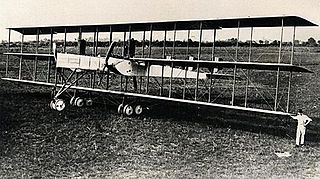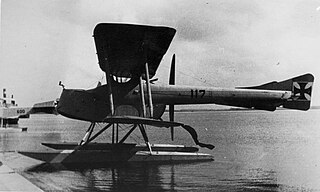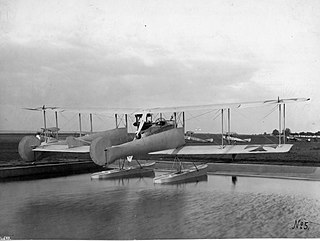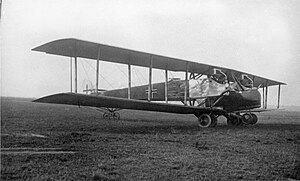
The Caproni Ca.4 was an Italian heavy bomber of the World War I era.

The Caproni Ca.1 was an Italian heavy bomber of the World War I era.

The Caproni Ca.2 was an Italian heavy bomber of the World War I era.

The Zeppelin-Staaken R.VI was a four-engined German biplane strategic bomber of World War I, and the only Riesenflugzeug design built in any quantity.

The Friedrichshafen G.I was a prototype heavy bomber aircraft that was built in Germany by Flugzeugbau Friedrichshafen in 1915. It was Karl Gehlen's first design for the company, and although it was not produced in quantity, it provided the foundation for the later, highly successful bombers culminating in the G.III.

The Friedrichshafen FF.31 was a two-seat prototype German maritime reconnaissance floatplane built by Flugzeugbau Friedrichshafen during the First World War. Although primarily intended for reconnaissance duties, the aircraft was provided with a machine gun to engage other aircraft. Although it was satisfactory for its intended mission, it lacked the performance necessary for use as a fighter. A pair of aircraft were built in 1915 and it was not accepted for production by the Imperial German Navy's Naval Air Service.

The Friedrichshafen FF.34 was a German biplane floatplane of the 1910s produced by Flugzeugbau Friedrichshafen.

The Gotha WD.3 was a prototype maritime reconnaissance floatplane developed during World War I by Gothaer Waggonfabrik (Gotha) for the Imperial German Navy's Naval Air Service. The three-seat aircraft used the pusher configuration with the engine behind the crew. It was lacking in performance compared to aircraft with the more common tractor configuration with the engine in the nose and was not approved for production. The single prototype completed was used as a training aircraft; its ultimate fate is unknown.

The Rumpler G.I was a bomber aircraft produced in Germany during World War I, together with refined versions known as the G.II and G.III.
The Bristol Type 6 T.T.A was a British two-seat, twin-engine biplane, designed in 1915 as a defence fighter. Two prototypes were built, but the T.T.A. did not go into production.

The Siemens-Schuckert R.II was a prototype bomber aircraft built in Germany during World War I. It was one of six aircraft based on the Siemens-Schuckert R.I that were originally intended to be identical, but which each developed in a different direction and were designated as different aircraft types by the German Inspectorate of Flying Troops. Although the R.II was the first of the batch to be completed, it was the last accepted into military service, and then only as a trainer.

The Zeppelin-Staaken Riesenflugzeuge were a series of very large bomber aircraft - Riesenflugzeuge, usually powered by four or more engines, designed and built in Germany from 1915 to 1919.

The Siemens-Schuckert DDr.I was a World War I German twin engine, push-pull configuration triplane fighter aircraft. Only one was built, crashing on its first flight.

The LFG Roland G.I was a large prototype single-engine biplane bomber built in Germany in 1915, during World War I. It had a single engine buried in the fuselage driving pusher configuration propellers mounted on outriggers.

The LVG G.III was a large, twin engine triplane bomber built in Germany near the end of World War I. Only one was completed.

The Schütte-Lanz G.I was a large, twin engine, pusher configuration, experimental biplane built in Germany early in World War I. Only one was completed.

The Albatros C.XIV was a German two seat, single engine, biplane fighter aircraft built in 1918. Only one was constructed.

The Caudron Type D was a French pre-World War I single seat, twin-boom tractor biplane, a close but slightly smaller relative of the two seat Caudron Type C. More than a dozen were completed, one exported to the United Kingdom, where they may also have been licence built, and three to China.
The Caproni Ca.61 was an Italian heavy day bomber aircraft of 1922. It was the final development of the Caproni three engine, twin boom biplane types developed during World War I, but it was not put into production.
The Caproni Ca.66 was an Italian night bomber designed to reequip the post-World War I Italian Air Force. Only two examples of the four-engined biplane were built.
















